Abstract
This paper explores cognitive functions of adolescents with various online activity on the Internet. The study involved 100 adolescents (Moscow, Russia). The adolescents were divided into groups: 11–13 years old (N = 50), and 14–16 years old (N = 50). Specially selected neuropsychological methods were used to study cognitive functions. All the adolescents were divided into groups according to the criterion of varying degrees of online activity’s intensity: low (33%), medium (31%), controlled high (19%) and uncontrolled high (17%) intensity of Internet use. The adolescents with the average level of Internet use in comparison to the other groups showed better results in such neuropsychological characteristics as programming and control, visual spatial memory, selectivity of auditory verbal memory, verbal intelligence and erudition. The lowest results in these characteristics were shown by the adolescents from the groups with the high level of online activity. When comparing the younger and older adolescents, the same pattern remained in the younger group. When undergoing neuropsychological tests, the adolescents aged 11-13 years with the average level of user activity were more productive than the adolescents with low and high online activity. In the group of the older adolescents, this pattern was absent. In this regard, it can be concluded that the younger an adolescent is, the more the development of his/her cognitive functions depends on the amount of time he/she spends online. In this study, some optimum time spent by the adolescents on the Internet was observed. When that optimum time frame provided, higher rates of certain cognitive functions’ development are present, especially among the adolescents from the younger age group.
Keywords: Digital technologiesneuropsychological assessmentcognitive functionsuser activity
Introduction
Information and communications technologies and above all the Internet are increasingly entering the life of modern children and adolescents. The new cultural and psychological phenomenon - digital childhood - is determined by the certain social situation of the modern child’s development. This situation changes the forms of the child’s interaction with the external world (Soldatova, 2018). Appearing empirical facts confirm that information and communications technologies as cultural tools of modern times not only form new values and social practices but also influence the personal and cognitive development of children (Soldatova, Rasskazova, & Nestik, 2016).
Problem Statement
Despite the growing number of works about the impact of digital devices on personal and mental development of children (Jackson et al., 2012; Barr, Pennycook, Stolz, & Fugelsang, 2015; George & Odgers, 2015, etc.), there is a lack of systematic studies of such important mental functions as memory, attention, thinking and speech and their qualitative changes determined by the intensity of Internet use. In the modern world it is impossible to fully protect a child from digital technologies; therefore, the issues not only about the content of children's online activities but also determining the optimal amount of time they could spend on the Internet not only harmlessly but, on the contrary, for the benefit of their personal and cognitive development are becoming burning ones. By using a range of neuropsychological methods, some aspects of memory, attention and verbal functions of adolescents with different intensity of Internet use are analyzed in this study. The level of voluntary regulation and serial organization of activity is also examined as a necessary basis for the successful functioning of these cognitive processes. This study is a continuation of the work on studying the impact of Internet use on the cognitive functions of children and adolescents, which was began in 2017 (Soldatova, Vishneva, & Chigarkova, 2018).
Research Questions
The relation between the intensity of Internet use and a number of characteristics that reflect the development of cognitive functions of children aged 11 to 16 years are analyzed in this study. In this regard, it is assumed, firstly, that there is some optimum time spent by adolescents on the Internet, which contributes to a more harmonious development of higher mental functions, especially the voluntary regulation of activity. Secondly, the younger an adolescent is, the more prominent will be the relation between successful undergoing neuropsychological tests and the optimal time spent online.
Purpose of the Study
The main objectives of this study were: division of adolescents into groups depending on the intensity of their user activity, identification and description of differences in cognitive functions of adolescents with different user activity, study of the interrelation between user activity and cognitive functions of the adolescents from the two age groups: the group of younger adolescents (11-13 years old), the group of older adolescents (14-16 years old).
Research Methods
Samples
The study involved 100 adolescents: younger adolescents (11–13 years old, 53 people) and older adolescents (14–16 years old, 47 people). The sample of children was balanced by gender and age.
Methods
For carrying out this study, a methodological complex was developed and tested: 1) a neuropsychological evaluation, 2) a sociopsychological questionnaire that included several blocks of questions and special psychological methods and methodological techniques.
The study was conducted at home in families in the form of an individual interview with each adolescent where the parents filled out the sociopsychological questionnaire.
The range of neuropsychological tests included the following methods (Akhutina, 2016): 1) Dynamic praxis; 2) Auditory verbal memory (immediate and delayed memorization of 2 groups with 3 words each); 3) Counting operations, serial counting; 5) Visual spatial memory (immediate and delayed memorization of 4 difficult verbalized patterns); 6) Making up a story based on a series of plot pictures; 7) Hedge graphic test; 8) Dots test (on the computer); 9) Subtests from the children's version of the Wechsler test - Knowledge and Comprehension.
Methods of neuropsychological testing were aimed at the study of the following neuropsychological indices: 1) programming and control (skills of analyzing the conditions of the task being undertaken, developing and mastering the algorithm of actions, monitoring their implementation); 2) serial organization of movements and actions (smoothness of interchanging from one program component to another, including when undertaking intellectual tasks); 3) auditory verbal memory; 4) visual spatial memory; 5) maintaining tone and concentration. The subtest Knowledge tests verbal intelligence (level of knowledge, scope of interests and erudition and the ability to store this information in long-term memory). This subtest has high correlations with overall intelligence. The subtest Comprehension determines the ability to model your own behavior in different situations.
The obtained results were processed using the statistical software IBM SPSS Statistics 22. The following procedures were carried out: correlation analysis, single factor analysis of variance (ANOVA), multivariate analysis of variance (MANOVA), which revealed the interrelation of age and online activity factors and their effect on neuropsychological results.
Findings
Based on the frequency distribution, all the adolescents were divided into the following groups according to their user activity of digital devices and the Internet:
Time online includes not only using social networks, searching for information, publishing posts, but also chatting in messengers (WhatsApp, Viber, Twitter etc.), viewing photos on Instagram.
Differences in the results of the neuropsychological tests for the adolescents with different user activity
According to the results of single factor analysis of variance (ANOVA), the maximum number of significant differences was obtained with the respect to the following neuropsychological indices: programming and control, visual spatial memory, verbal intelligence and erudition following the Knowledge subtest.
On average the adolescents with
The adolescents with
On average the adolescents from the groups of controlled and uncontrolled high online activity coped worse with the proposed tasks than the others, with the exception of the reaction time in the computer test Dots where their performance was the same as the performance of the “medium” group (0.50 second). They worse performed counting operations in their heads than the other adolescents and on average made 1-2 errors without self-correction (controlled high user activity r = 1.11, uncontrolled high activity r = 1.47, significance of differences p≤0.05). The effectiveness of memorizing patterns in the method for visual spatial memory of the adolescents with high user activity during the first-time reproduction of patterns differed significantly. At the first-time reproduction, they memorized 2-3 patterns from the series of five patterns (controlled high activity r = 2.95, uncontrolled high activity r = 2.75). Despite the low performance of visual memory, the adolescents from these groups rarely had inaccuracies and added non-existent patterns which indicates a good selectivity of their visual memory while it has small capacity. In the Wechsler verbal subtest Knowledge, on average the adolescents from these groups got lower score than the adolescents from the other groups. This indicates insufficient erudition and verbal intelligence of the adolescents with this intensity of online activity.
Thus, some optimum time spent by adolescents on the Internet was observed in our study. The adolescents who spend from 3 to 5 hours online are better oriented in conditions of tasks, have better control over the implementation process, make less mistakes, have better immediate visual memory capacity and good selectivity of auditory verbal memory. They show greater knowledge and erudition, demonstrate better awareness. The adolescents with low online activity demonstrate an average level of cognitive development comparing to the adolescents from the other groups, except for the reaction time in the computer test where they reacted more slowly than the others. The adolescents from the groups with high online activity coped worse with the proposed methods which indicates a reduced level of cognitive development comparing to the other groups.
Differences in the results of the neuropsychological tests for the two age groups with different online activity
According to the results of the multivariate analysis of variance MANOVA, differences in neuropsychological indices were observed depending on the age and online activity of the respondents, which examined functions of
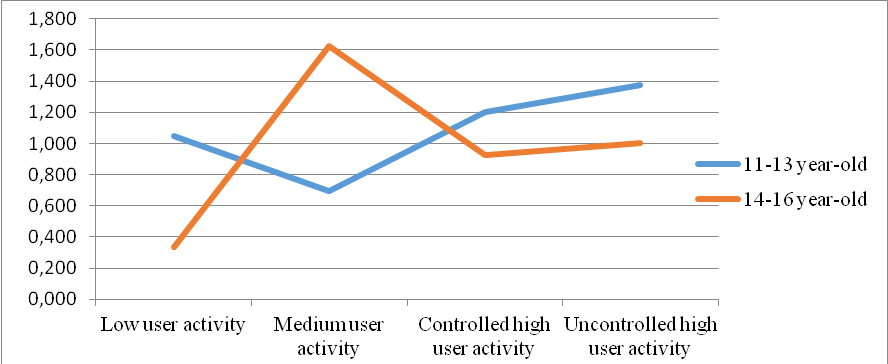
Figure
The index with a large number of differences was also the scale Grammatical Structure of the Story, which tests the functions of serial organization. The absence of errors is coded as 0 points; the maximum number of errors is 3 points (agrammatism and multiple syntactic errors, omissions of the verbal predicate). In the two age groups, the opposite trend is observed.
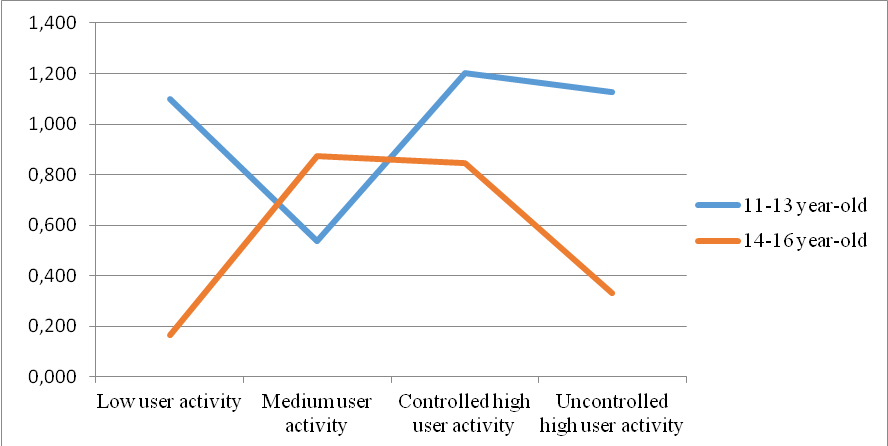
Among the adolescents from
Significant differences were also noted in the results of the method for visual spatial memory. This method tests visual memory capacity and maturity of visual spatial functions.
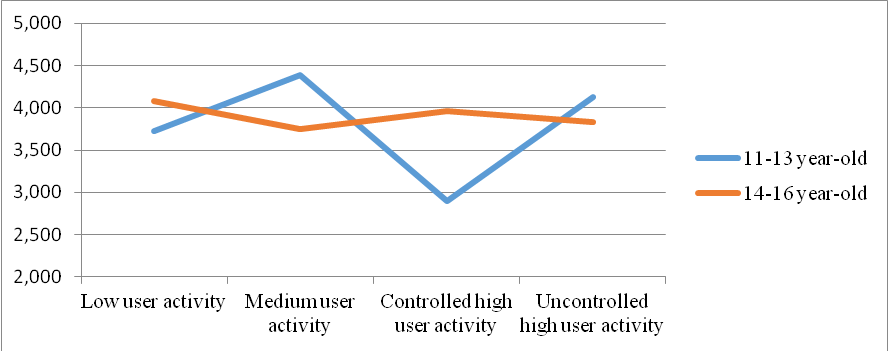
In the group of
Significant differences were observed on the scale Right Hemisphere Errors in the visual spatial memory.
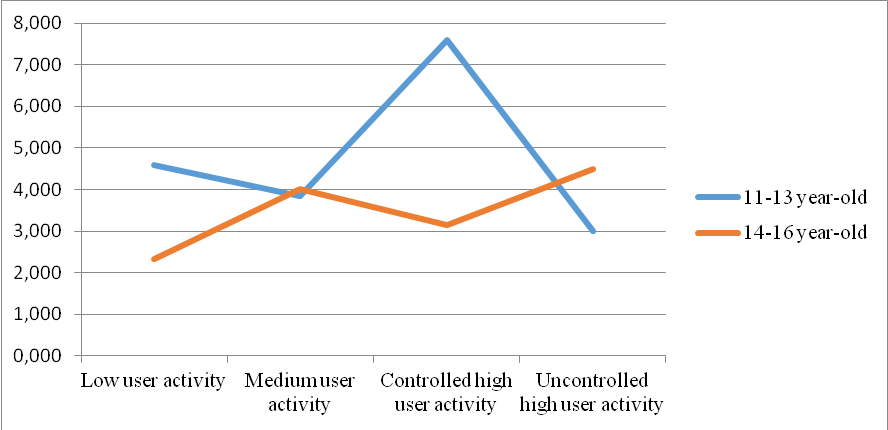
For
Differences as a trend were observed in the background components of movements when undertaking a manual test in the two groups of the adolescents with different activity. This index tests the energy block of functions which includes hand muscle tone (background components of movements), performance, pace of activity, fluctuations of attention. The absence of tonic errors is 0 points; the presence of errors (incomplete clenching of the fist, unfinished movements, excessive amplitude of movements, increased tone) is 1 point.
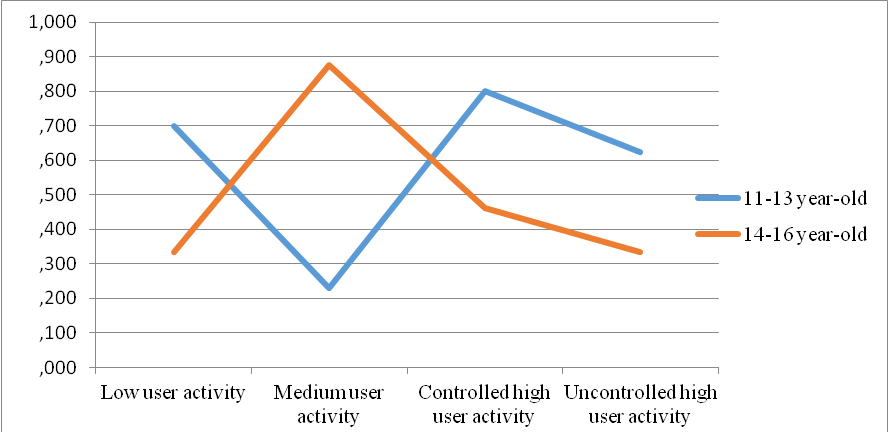
In the
Thus, according to the results of this study, various profiles of the cognitive productivity of neuropsychological tests for the younger and older adolescents were obtained depending on the duration of Internet use per day. The pattern obtained throughout the sample is retained in the group of the younger adolescents. In this age group, such higher mental functions of the adolescents with medium online activity as voluntary regulation and control, serial organization of movements and actions, verbal functions, visual spatial memory were better developed than the ones of the adolescents with low and high activity. This was demonstrated by the better performance when undergoing neuropsychological methods. In the group of the older adolescents, this pattern was absent; the indicators of cognitive success depended less on time spent on the Internet. On average in the group of the older adolescents, the adolescents with low activity were better at storytelling and used better grammatical structures. At the same time, the adolescents from the group with high activity showed almost the same good results. Significant differences in the performance of visual memory depending on the online activity by the older adolescents was not observed.
Conclusion
In this study, differences in cognitive functions of adolescents with different online activity are identified and described. When analyzing the entire sample of the adolescents, the adolescents with medium online activity (from 3 to 5 hours per day) turned out to be the most productive in undertaking the neuropsychological tests. They showed the best performance in programming and control, visual spatial memory, and verbal intelligence. This gave us the opportunity to assume that 3-5 hours online, including chatting in messengers and chats, is the optimum time that combined with offline activity contributes to the cognitive development and erudition of adolescents. When the adolescents were divided into age groups, the pattern of cognitive functions depending on online activity turned out to be slightly different comparing to the pattern when the adolescents were not divided. In the group of the younger adolescents, the obtained pattern preserved: the most successful in programming in terms of verbal functions and visual memory were the adolescents with medium online activity. But in the group of the older adolescents, this pattern following the main indices was absent or opposite. Thus, it can be proposed that the younger an adolescent is, the more the development of his/her cognitive functions depends on the time he/she spends online. It can also be proposed that for older adolescents the optimum time spent on the Internet is different. The obtained phenomena and patterns require further deeper analysis.
Acknowledgments
The research is supported by the Russian Foundation for Basic Research, project No. 17-06-00762.
References
- Akhutina, T.V. (2016). Methods of the neuropsychological examination of children aged 6-9 years. Moscow: Sekachev (in Russian).
- Barr, N., Pennycook, G., Stolz, J.A., & Fugelsang, J.A. (2015). The brain in your pocket: Evidence that Smartphones are used to supplant thinking. Computers in Human Behavior, 48, 473–480.
- George, M.J., & Odgers, C.L. (2015). Seven fears and the science of how mobile technologies may be influencing adolescents in the digital age. Perspectives on psychological science, 10(6), 832–851.
- Jackson, L.A., Witt, E.A., Games, A.I., Fitzgerald, H.E., von Eye, A., & Zhao, Y. (2012). Information technology use and creativity: Findings from the Children and Technology Project. Computers in Human Behavior, 28, 370 – 376.
- Soldatova, G.U., Rasskazova, E.I., & Nestik, T.A. (2016). Digital generation of Russia: competence and safety. Moscow: Smysl. (in Russian).
- Soldatova, G.U. (2018). Digital socialization in the cultural-historical paradigm: a changing child in a changing world. Social Psychology and Society, 9(3), 71 – 80. (in Russian).
- Soldatova, G., Vishneva, A., & Chigarkova, S. (2018). Features of cognitive processes in children with different internet activity. European Proceedings of Social and Behavioural Sciences, 43, 611 – 617.
Copyright information

This work is licensed under a Creative Commons Attribution-NonCommercial-NoDerivatives 4.0 International License.
About this article
Publication Date
14 July 2019
Article Doi
eBook ISBN
978-1-80296-063-1
Publisher
Future Academy
Volume
64
Print ISBN (optional)
-
Edition Number
1st Edition
Pages
1-829
Subjects
Psychology, educational psychology, counseling psychology
Cite this article as:
Soldatova*, G., & Vishneva, A. (2019). Feathers Of The Cognitive Sphere In Adolescent Internet Users. In T. Martsinkovskaya, & V. R. Orestova (Eds.), Psychology of Subculture: Phenomenology and Contemporary Tendencies of Development, vol 64. European Proceedings of Social and Behavioural Sciences (pp. 683-692). Future Academy. https://doi.org/10.15405/epsbs.2019.07.89
